This product is for research use only, not for human use. We do not sell to patients.

| Size | Price |
|---|---|
| 250mg | Get quote |
| 500mg | Get quote |
| 1g | Get quote |
Cat #: V2689 CAS #: N/A Purity ≥ 98%
Description: SGE-516, a synthetic neuroactive steroid, is a potent positive allosteric modulator of both synaptic and extrasynaptic GABAA receptors. Neuroactive steroids (NASs) have been shown to impact central nervous system (CNS) function through positive allosteric modulation of the GABA(A) receptor (GABA(A)-R). SGE-516 treatment protected against hyperthermia-induced seizures, reduced spontaneous seizure frequency and prolonged survival in the Scn1a +/- mice. This provides the first evidence of SGE-516 activity in a mouse model of Dravet syndrome, and supports further investigation of neuroactive steroids as potential anticonvulsant compounds for refractory epilepsies. As a balanced synaptic/extrasynaptic GABA(A) receptor modulator, and a selective extrasynaptic GABA(A) receptor modulator, SGE-516 possesses excellent druglike properties, making them advanced leads for oral delivery of GABA(A) receptor modulators.
Publications Citing InvivoChem Products
Product Promise

- Physicochemical and Storage Information
- Protocol
- Related Biological Data
- Stock Solution Preparation
- Quality Control Documentation
| Molecular Weight (MW) | 385.55 |
|---|---|
| Molecular Formula | C23H35N3O2 |
| CAS No. | N/A |
| Storage | -20℃ for 3 years in powder form |
| -80℃ for 2 years in solvent | |
| Solubility In Vitro | DMSO: 10 mM |
| Water: < 1mg/mL | |
| Ethanol: < 1mg/mL | |
| Synonyms | SGE-516; SGE516; SGE 516 |
| Protocol | In Vitro | In vitro activity: SGE-516, a synthetic neuroactive steroid, is a potent positive allosteric modulator of both synaptic and extrasynaptic GABAA receptors. Neuroactive steroids (NASs) have been shown to impact central nervous system (CNS) function through positive allosteric modulation of the GABA(A) receptor (GABA(A)-R). SGE-516 treatment protected against hyperthermia-induced seizures, reduced spontaneous seizure frequency and prolonged survival in the Scn1a +/- mice. This provides the first evidence of SGE-516 activity in a mouse model of Dravet syndrome, and supports further investigation of neuroactive steroids as potential anticonvulsant compounds for refractory epilepsies. As a balanced synaptic/extrasynaptic GABA(A) receptor modulator, and a selective extrasynaptic GABA(A) receptor modulator, SGE-516 possesses excellent druglike properties, making them advanced leads for oral delivery of GABA(A) receptor modulators. Kinase Assay: Cell Assay: Hyperthermia-induced seizure assays were performed on Scn1a +/− mice at P19-20. Core body temperature was monitored with a RET-3 rectal temperature probe (Physitemp Instruments, Inc, New Jersey, USA) and controlled by a heat lamp connected to a rodent temperature regulator (TCAT-2DF, Physitemp) reconfigured with a Partlow 1160 + controller (West Control Solutions, Brighton, UK). SGE-516 was administered by IP injection and mice were returned to their home cage for 40 minutes. The temperature probe was inserted at 40 minutes post-injection and mice acclimated to probe and test environment for 5 minutes. At 45 minutes post-injection, body temperature was raised 0.5 °C every two minutes until the onset of the first clonic convulsion with loss of posture or until 42.5 °C was maintained for 5 minutes. Mice that did not experience a GTCS during the 5-minute hold at 42.5 °C were considered seizure-free. Threshold temperatures were compared using the time-to-event analysis with P values determined with LogRank Mantel-Cox test. P values < 0.05 were considered statistically significant. |
|---|---|---|
| In Vivo | Scn1a tm1Kea mice, with deletion of the first coding exon, were generated by homologous recombination in TL1 ES cells (129S6/SvEvTac) and genotyped as previously described. The Scn1a +/− line is maintained by continuous backcrossing to 129S6/SvEvTac (129) (Taconic Biosciences, Hudson, NY, USA). Mice for experiments were generated by crossing 129.Scn1a +/− mice with C57BL/6 J (B6) (#000664, Jackson Laboratory, Bar Harbor, ME, USA), resulting in [129 x B6]F1.Scn1a +/− offspring, referred to herein as Scn1a +/− mice. Mice were maintained in a Specific Pathogen Free (SPF) barrier facility with a 14-hour light/10-hour dark cycle and access to food and water ad libitum. Both female and male Scn1a +/− mice were utilized for all experiments. There were no significant differences between sexes on any measurements, so groups were collapsed across sex. All animal care and experimental procedures were approved by the Northwestern University Animal Care and Use Committee in accordance with the National Institutes of Health Guide for the Care and Use of Laboratory Animals. The principles outlined in the ARRIVE (Animal Research: Reporting of in vivo Experiments) guideline and Basel declaration (including the 3 R concept) were considered when planning experiments. | |
| Animal model | Scn1a tm1Kea mice |
| Solvent volume to be added | Mass (the weight of a compound) | |||
|---|---|---|---|---|
| Mother liquor concentration | 1mg | 5mg | 10mg | 20mg |
| 1mM | 2.5937 mL | 12.9685 mL | 25.9370 mL | 51.8739 mL |
| 5mM | 0.5187 mL | 2.5937 mL | 5.1874 mL | 10.3748 mL |
| 10mM | 0.2594 mL | 1.2968 mL | 2.5937 mL | 5.1874 mL |
| 20mM | 0.1297 mL | 0.6484 mL | 1.2968 mL | 2.5937 mL |
This equation is commonly abbreviated as: C1 V1 = C2 V2
- (1) Please be sure that the solution is clear before the addition of next solvent. Dissolution methods like vortex, ultrasound or warming and heat may be used to aid dissolving.
- (2) Be sure to add the solvent(s) in order.




































